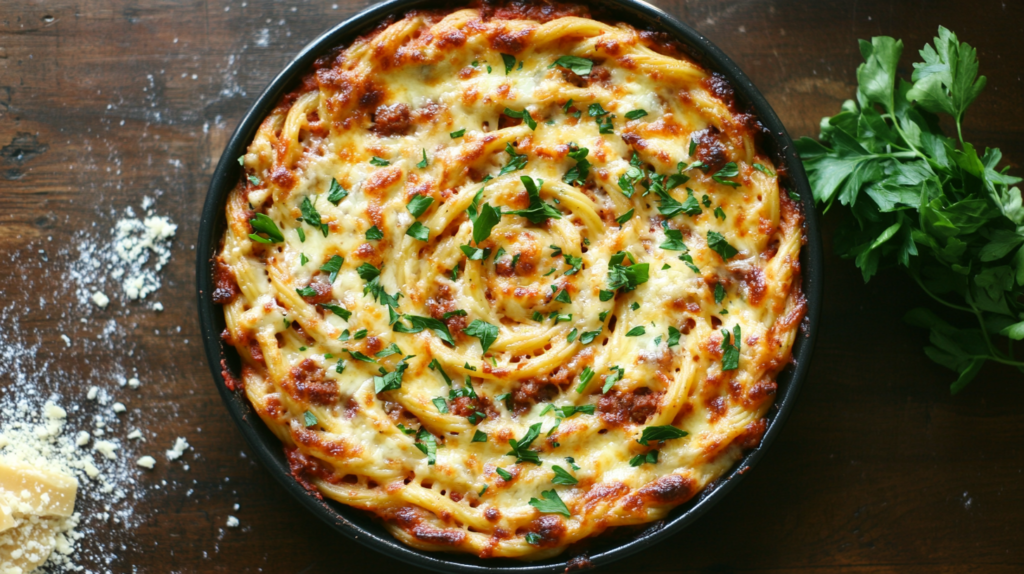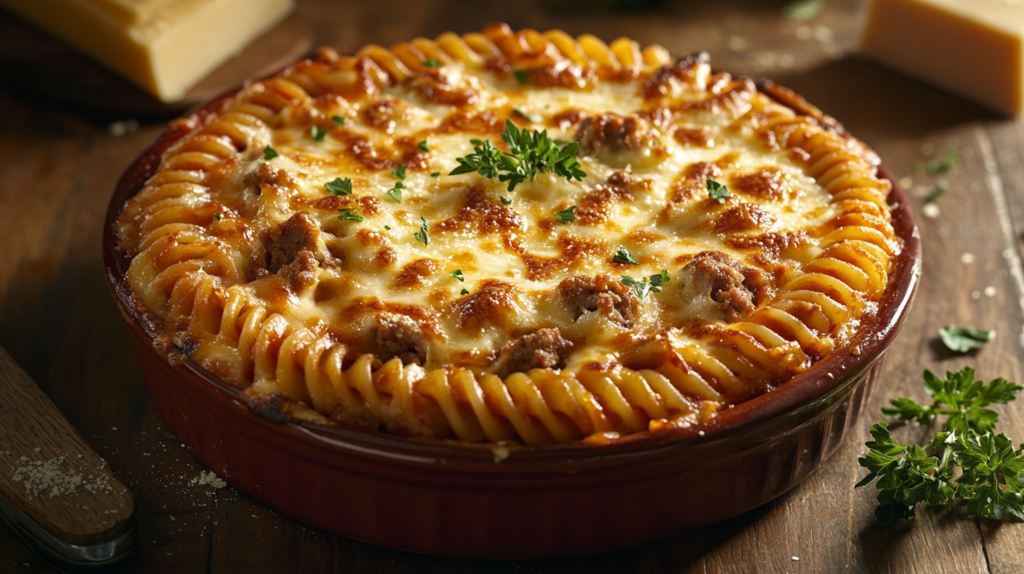Introduction to Rotini Pasta
Rotini pasta is one of the most popular pasta types, known for its corkscrew-like shape that holds onto sauces and ingredients beautifully. Originating from Italy, it has evolved into a global favorite for a variety of dishes, ranging from classic Italian recipes to modern fusion cuisine.
This spiral-shaped pasta is not only versatile but also aesthetically pleasing, making it a favorite for both home cooks and professional chefs. From baked dishes to cold salads, rotini is a staple ingredient in kitchens worldwide.
Explore a variety of versatile pasta recipes that showcase rotini’s adaptability.
What is Rotini Pasta?
Rotini is a short, twisted pasta that resembles a corkscrew. Its unique design is not just decorative—it serves a functional purpose by gripping sauces, cheeses, and spices, ensuring every bite is flavorful.
Key Characteristics of Rotini
- Shape: Corkscrew or spiral.
- Origin: Southern Italy.
- Material: Typically made from semolina flour, but also available in whole grain, gluten-free, and vegetable-infused varieties.
- Usage: Ideal for hot pasta dishes, cold salads, and baked casseroles.
Rotini’s versatility makes it a culinary superstar. From robust tomato sauces to light olive oil dressings, it pairs well with virtually any flavor profile.
The History of Rotini Pasta
The roots of rotini trace back to Southern Italy, where its spiral design was inspired by the act of spinning threads. The name “rotini” translates to “small wheels” in Italian, reflecting its coiled appearance.
Historically, rotini was crafted by hand, with pasta makers twisting thin strips of dough around thin rods. Over time, its popularity grew, and industrial pasta-making machines allowed for mass production, introducing rotini to a global audience.
Today, rotini remains a favorite in Italian households and beyond. Learn more about rotini’s history and versatility.

Nutritional Benefits of Rotini Pasta
Rotini is not just delicious; it can also be a nutritious addition to your diet, depending on the type you choose. Whether you’re looking for a high-fiber option or a gluten-free alternative, rotini has something for everyone.
Nutritional Profiles
- Traditional Rotini: Made from refined semolina flour, providing energy through carbohydrates and fortified with essential vitamins like iron and folic acid.
- Whole-Grain Rotini: Higher in fiber and protein, great for digestion and sustained energy.
- Gluten-Free Rotini: Made from rice, corn, or quinoa, suitable for those with gluten intolerance.
- Vegetable-Infused Rotini: Includes spinach, beet, or tomato powder for added nutrients and vibrant colors.
Rotini is also versatile for various diets. Combine it with lean proteins, fresh vegetables, and heart-healthy fats for a balanced, nutritious meal.
How to Cook Rotini Pasta Perfectly
Cooking rotini correctly ensures its signature texture and flavor are preserved. Here’s a foolproof guide to cooking rotini like a pro.
Step-by-Step Instructions
- Boil Water: Use a large pot with 4–6 quarts of water per pound of pasta. Add a generous pinch of salt for flavor.
- Add Rotini: Once the water reaches a rolling boil, add the pasta and stir to prevent sticking.
- Cook to Al Dente: Follow the package instructions, typically 8–10 minutes, for perfectly firm pasta.
- Drain and Serve: Drain the pasta, reserving some cooking water for sauces.
Pro Tip: For cold salads, rinse the pasta under cold water to cool it down and prevent further cooking.
Sauces and Pairings for Rotini Pasta
The corkscrew design of rotini makes it a versatile partner for a variety of sauces and ingredients. Its twists hold onto sauces exceptionally well, ensuring a balanced flavor in every bite.
Top Sauce Pairings
- Tomato-Based Sauces: Marinara, arrabbiata, and Bolognese work beautifully with rotini.
- Oil-Based Sauces: Pesto, garlic-infused olive oil, or lemon and herb vinaigrettes.
- Creamy Sauces: Alfredo, cheese sauce, or cream-based mushroom sauces.
Check out this creamy mushroom recipe for inspiration.
Rotini Pasta in Salads
Rotini pasta is a star in cold pasta salads, thanks to its ability to hold onto dressings and small ingredients. It’s a favorite for summer barbecues, potlucks, and light lunches.
Popular Salad Ideas
- Mediterranean Rotini Salad: Toss rotini with cherry tomatoes, cucumbers, feta, olives, and a lemon-oregano vinaigrette.
- Classic Italian Pasta Salad: Combine rotini with salami, mozzarella, roasted red peppers, and Italian dressing.
- Vegan Rotini Salad: Use a dairy-free dressing and load up on veggies like spinach, bell peppers, and artichokes.
For a Mediterranean twist, explore this quinoa power bowl for inspiration.
Baked Rotini Dishes
Baked pasta dishes are the ultimate comfort food, and rotini pasta is an excellent choice for these hearty meals. Its spiral shape absorbs flavors and holds its texture during baking.
Delicious Baked Recipes
- Cheesy Rotini Casserole: Layer rotini with marinara, ricotta, and shredded mozzarella. Bake until bubbly and golden.
- Rotini Lasagna: Replace lasagna sheets with rotini for a fun twist on the classic dish.
- Vegetarian Baked Rotini: Combine rotini with roasted vegetables, marinara, and Parmesan.
Discover other flavor-packed baked dishes.
Gluten-Free and Dietary Variations
For those with dietary restrictions or preferences, there are plenty of rotini options available:
- Gluten-Free Rotini: Made from rice, quinoa, or chickpeas.
- Low-Carb Rotini: Explore options made from lentils or zucchini spirals.
- Vegan Rotini: Combine with plant-based sauces and dairy-free cheese alternatives.
These variations ensure everyone can enjoy the deliciousness of rotini pasta without compromising their dietary needs.
FAQs About Rotini Pasta
What is the difference between rotini and fusilli?
While both are spiral-shaped pasta, rotini has tighter corkscrews, whereas fusilli has a more open spiral.
How long does rotini take to cook?
Most rotini pasta cooks in 8–10 minutes. For the best texture, cook it al dente.
Can I freeze cooked rotini?
Yes, cooked rotini can be frozen. Store it in an airtight container for up to three months.
What are the best sauces for rotini?
Rotini pairs well with tomato-based sauces, oil-based dressings, and creamy Alfredo-style sauces.
Is rotini pasta gluten-free?
Traditional rotini is not gluten-free, but there are gluten-free versions made from alternative flours like rice and corn.
Fun Facts About Rotini Pasta
- Rotini is a favorite among kids due to its fun, spiral shape.
- The shape was inspired by the process of spinning threads, reflecting its Italian craftsmanship.
- It is a top choice for potluck dishes like pasta salads and baked casseroles.
Conclusion
Rotini pasta is much more than a simple ingredient—it’s a culinary chameleon that adapts to a wide variety of dishes and cuisines. From classic Italian meals to innovative gluten-free options, rotini’s unique shape, history, and versatility make it a must-have in every kitchen.
Explore more recipes, from creamy pasta dishes to light and healthy salads, at Recipes4Hub. Whether you’re a home cook or a seasoned chef, rotini pasta is your ticket to creating unforgettable meals.



